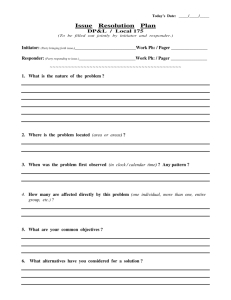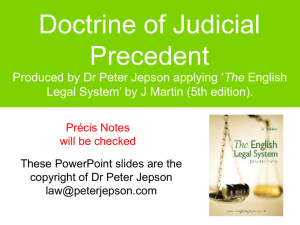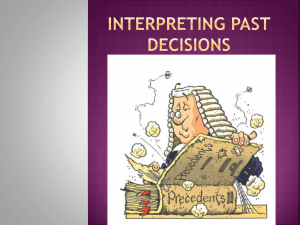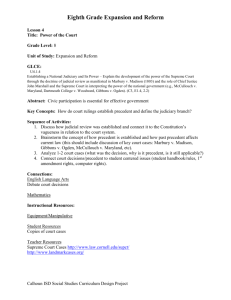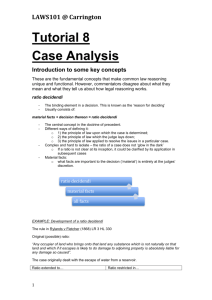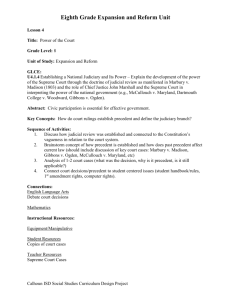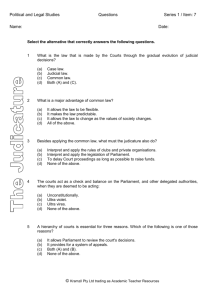The Doctrine of Precedent
advertisement
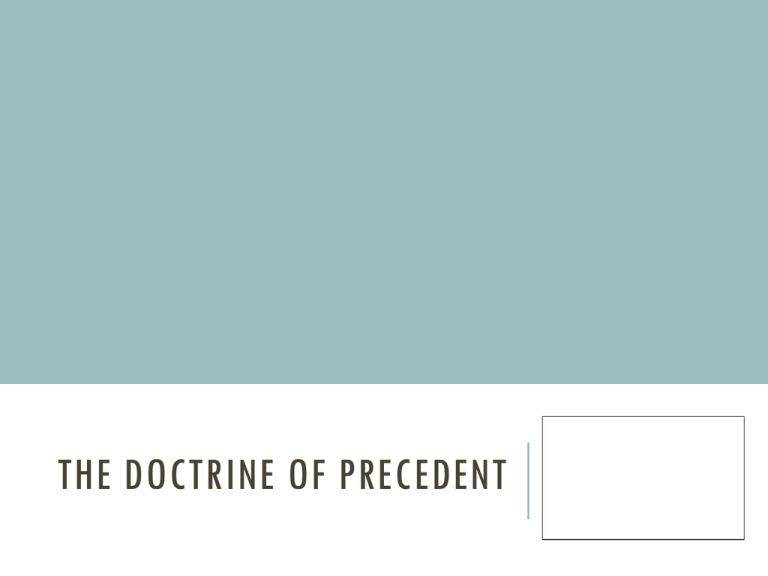
THE DOCTRINE OF PRECEDENT PRECEDENT A previous decision made by a superior court on similar facts - it requires that in certain circumstances a decision made on a legal point made in an earlier case must be followed The doctrine of precedent (stare decisis) The hierarchy of courts THE DOCTRINE OF PRECEDENT • Stare decisis • The doctrine of judicial precedent is based on stare decisis. That is the standing by of previous decisions. Once a point of law has been decided in a particular case, that law must be applied in all future cases containing the same material facts. • The doctrine is: All courts are bound to follow decisions made by courts above them; Appellate courts are normally bound by their own past decisions THE DOCTRINE OF PRECEDENT – CONT. The doctrine works by requiring judges to follow the decisions made in previous cases, thus ensuring that there is a consistency in the law and that people coming to the law will be able to make an educated guess as to the potential success and likely outcome of their case THE HIERARCHY OF COURTS When a point of European Law is involved, the decisions of the European Court of Justice are binding on all courts in England and Wales The House of Lords used to be the highest court in England and Wales; now it is the Supreme Court of the UK Hierarchy: The Supreme Court Court of Appeal Divisional Courts (High Court) Inferior courts: Crown Court, Magistrates’ Court, County Court, Tribunals ECJ European Court of Justice The European Court of Justice does not recognise the doctrine of precedent and is free to depart from its own previous decisions. Decisions from the ECJ are binding on all courts in England & Wales. TYPES OF PRECEDENTS Original Declaratory Binding Persuasive ORIGINAL PRECEDENT Where there is no previous decision on a point of law that has to be decided by a court, then the decision made in that case on that point of law is an original precedent When the court has to form an original precedent, the court will reason by analogy (considering the cases that are nearest to it in principle) DECLARATORY PRECEDENT The judges in the case merely declared what the law has always been Declaratory theory of law making According to William Blackstone judges do not create or change laws. They simply discover and declare what the law has always been. This means that case law operates retrospectively since the law as declared has always existed. BINDING PRECEDENT A past decision is binding if: The legal point involved is the same as the legal point in the case now being decided The earlier decision was made by a court above the present court in the hierarchy, or a court at the same level which is bound by its own past judgments The point was argued in the case PERSUASIVE PRECEDENT The one which the court will consider and may be persuaded by, but which does not have to be followed, such as obiter dicta, a dissenting judgment or ratios from decisions by courts lower in hierarchy LAW REPORTS The reasons for decisions of past cases must be properly recorded in order for a system of precedent to operate effectively From 1537 to 1863 various private law reports were used Since 1863 the Incorporated Council of Law Reporting has produced the official law reports Judgments of superior courts are available on their official sites on the Internet RATIO DECIDENDI In order for the doctrine of judicial precedent to work, it is necessary to be able to determine what a point of law is. In the course of delivering a judgment, the judge will set out their reasons for reaching a decision. The reasons which are necessary for them to reach their decision amount to the ratio decidendi of the case. The ratio decidendi forms the legal principle which is a binding precedent meaning it must be followed in future cases containing the same material facts. Ratio decidendi - the reason for the decision The principles of law that are essential to the decision Defined as ‘any rule expressly or impliedly treated by the judge as a necessary step in reaching his conclusion’. OBITER DICTA Statements in passing (‘things said by the way’) Statements of principles of law that are not relevant to the decision Can be persuasive AVOIDING PRECEDENT Judges may avoid following a previous precedent by: •Overruling •Reversing •Distinguishing Overruling This is where a court higher in the hierarchy departs from a decision made in a lower court. The previous decision is no longer binding. Reversing This is where a higher court departs from the decision of the lower court on appeal. Distinguishing This is where the facts of the case are deemed sufficiently different so that the previous case is no longer binding. ARGUMENTS FOR THE DOCTRINE Time saving Certainty Justice Consistency Flexibility ARGUMENTS AGAINST THE DOCTRINE Promotes laziness Stagnation Backwards looking Difficult to remedy mistakes VOCABULARY Binding precedent – obvezujući presedan Persuasive precedent – preporučljivi presedan Precedent law – pravo riješenih slučajeva Divisional courts – sudski odjeli Visokog suda Law Reports – zbirka sudskih odluka Dissenting judgment – sudska odluka uz izdvojeno mišljenje Ratio decidendi – razlog za donošenje odluke Obiter dicta – usputne primjedbe THANK YOU FOR YOUR ATTENTION!
